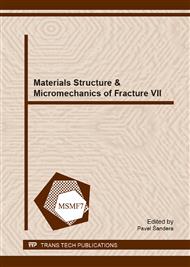p.382
p.389
p.393
p.397
p.401
p.405
p.409
p.413
p.417
Fibre-Matrix Interface Development during High Temperature Exposition of Long Fibre Reinforced SiOC Matrix
Abstract:
The fracture behaviour of long fibre reinforced composites is predetermined mainly by properties of fibre-matrix interface. The matrix prepared by pyrolysis of polysiloxane resin possesses ability to resist high temperatures without significant damage under oxidising atmosphere. The application is therefore limited by fibres and possible changes in the fibre matrix interface. The study of development of interface during high temperature exposition is the main aim of this contribution. Application of various techniques as FIB, GIS, TEM, XRD allowed to monitor microstructural changes in the interface of selected places without additional damage caused by preparation. Additionally, it was possible to obtain information about damage, the crack formation, caused by the heat treatment from the fracture mechanics point of view.
Info:
Periodical:
Pages:
401-404
Citation:
Online since:
November 2013
Authors:
Keywords:
Price:
Сopyright:
© 2014 Trans Tech Publications Ltd. All Rights Reserved
Share:
Citation:


